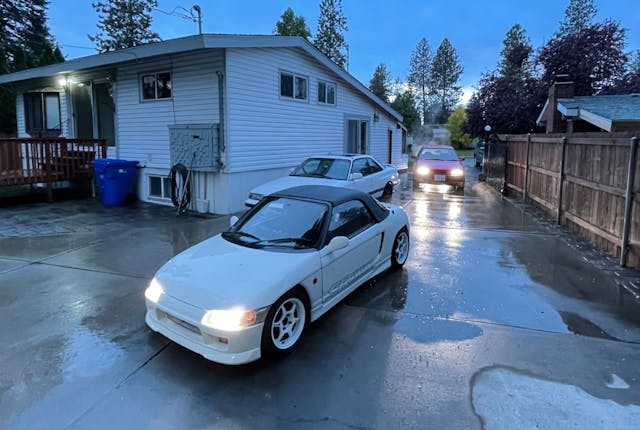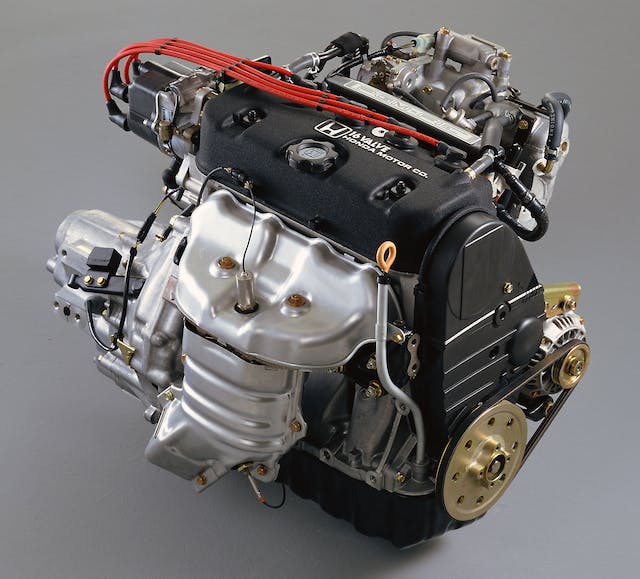Media | Articles
Smithology: The dream of City life
The interior was mostly gone. The engine burped out blats and toots. One lane over, in another car, the owner beamed.
I drove! A Honda City!
A track-prepped 1992 Honda City!
A small car that bops down the road like an exclamation point and thus virtually requires said punctuation upon reference!
Sean Brauner’s Honda was not the reason I left my house in Tennessee before dawn on a Monday and flew to Spokane, Washington for just under 24 hours. What it was, was icing on the cake.
Marketplace
Buy and sell classics with confidence

For this we blame Griff Shelley, another Spokanite. Shelley introduced me to Brauner. The two have known each other since grade school. Griff recently helped Hagerty give away a Volvo in a contest. I was in Washington for that contest’s finale, to hand the car to the winner. Griff allowed as how we should stop by Sean’s place, maybe take a few of the man’s tiny foreign cars to dinner.
Opt-outs were evaluated. A migraine had checked into my skull on the flight. Insomnia the night before had allowed just two hours of sleep. One of my shoelaces was fraying, maybe six months from a break. Trivial stuff.
“Do not,” I told Griff, “threaten me with a good time.”

This all took place in a Pacific Northwest autumn. It was thus perpetually raining, or just about to rain, or perhaps slowly drying up before the sky tried something different for a change, like having the clouds whiz out a few quintillion bits of water from very high up. I stood in Sean’s driveway and recalled, through the miracle of sensory flashback, why I once lived in Seattle. Also why I developed there, and came to love, a coffee intake so stout as to wake Caesar. I looked at Sean’s garage.
“You really don’t care if we drive these in the wet?”
“Nah,” he said, chipper. “Gives me a reason to clean them again!”
Brauner, 32, appears to have solved one of life’s key equations. He seems happy. One piece of that happiness is the improbably large four-car garage behind his modest suburban home, built by a previous owner. Inside, on that Monday, sat a track-prepped 1991 Honda Beat (660-cc four, rear-drive and mid-engine, a roadster), a virtually stock ’89 Mazda Familia (1.8 liter turbo four, all-wheel-drive, a two-door hatch), and, in the corner, that modded City.

As the doors rolled up, I stood there, blinking.
“Please tell me,” I said, “that you basically woke up one day, like . . . I have a real job, I have some money . . . screw it, we’re buying tiny s*** in Japan.”
He laughed. “Basically, yeah.”
Later, over drinks, Brauner outlined the process. The development of a relationship with a Japanese broker. Hours spent poring through listings on a Japanese wholesale-auction site. Then, finally, a purchase, sight-unseen and dusted in faith. Some fun little right-hand-driver common enough to be frighteningly affordable. And small enough to ride a freighter across the Pacific for relative pennies. Crucially, he does not at any point pay mark-up to a stateside importer or get on a plane to Tokyo.
The conversation was eye-opening. People privately import older Japanese cars all the time; because most Americans err toward rare models, however, the process usually means big spend. Having pondered Nissan GT-R imports for years, I had never considered Sean’s approach. I just assumed all paths were costly, no matter the car.

When the Hondas fired up, my headache vanished. A stock ’92 City weighs 1700 pounds. The 6500-rpm, 1.3-liter four at the front wheels of Sean’s car made 100 hp when new. His City, modified in Japan before purchase, might have been stronger. It was also likely lighter than stock. I was so geeked, I forgot to ask specifics on either, which is fine, because specifics are irrelevant to the point.
We have here a vehicle larger than a Japanese kei car—that class of famously tiny, 660-cc commuteboxes, e.g. Honda Beat. It is, however, still a Nipponese subcompact. Smaller than any sane automobile sold in America in decades. You could park it in a household bathroom and still have room to flush.
Not a half-bath, though. Only the big ones, with the double sinks.

Dinner was at a brewery about 40 minutes away. I drove the Mazda there and climbed out buzzing. After we ate, I took the City back to Sean’s house, following Griff in the Mazda.
Griff did not appear to be slouching at the wheel. Or maybe the Honda was simply so puny-spicy-loud-vibrate-punk that every lane change at the speed limit needed full touge aggro. My mental age dropped by three decades when the door latched shut. Impromptu stoplight drags were lost to anything on wheels. The car resembled every not-sold-here supermini hatch I have ever tried, Japanese or European, just with more, as the vulgar say, f***.
There may have been a racing seat. The shifter was a footlong chrome stick under a white cue ball. (Pep Boysozuku?) The Alcantara steering wheel was dished, but only enough to feed a dog. Somewhere in that four-cylinder fuel compactor lived, on an exercise wheel with a squeaky bearing, a rodent of unusual size. Meanwhile, a large baseball card under the taillights flapped against the spokes of a bent wire wheel stolen from what I can only assume was some poor Tokyo kid’s bicycle.
Cliché? Is the rhetorical question a lazy writing device? When the legend turns fact, who doesn’t print the legend?

Every modified car is an assembly of choices, and one of the fun parts of this business is how the sum of those choices can be both outside your personal taste but so cohesive as to be unassailable. Turning the steering wheel moved relevant items in the Honda’s undergarments, where some enterprising individual had, as the British say, offered up extra spring rate, plus aftermarket shocks with bags of rebound. A comically excessive yet somehow cheery amount of caster populated the front axle. Mere inches away was a large speaker that kept distracting me in traffic by playing a looped tape of some middle-aged Tennesseean spitting peals of laughter.
The City’s roll cage was one of those odd setups where the front down-tube bends suggest immediate fold-over in a crash. After some consideration, I simply resolved to not crash. The execution of this plan did not lack entertainment, except when the Honda entered a corner in such a way as to basically scream for full commitment, which was always, which is probably why somebody gave it a roll cage to begin with.

On a rain-slicked road whose name I can’t recall, that baseball card flapping away, the City and I went hooping into a roundabout at full throttle.
In Japan, in the early 1980s, an earlier model of this car offered, as accessory, a scooter engineered to fit in the trunk.
That scooter was called the Honda Motocompo.
Years back, in a friend’s garage, I sat on a Motocompo and made a face.

In the roundabout, my face made the face again.
Tuesday morning, Sean and Griff and I met the Volvo winner, a gent named Matt, at a diner for breakfast. I asked how everyone got into cars.
“When I was 16,” Sean said, “a lady in my neighborhood let me drive her Z06.”
I blinked again, but loudly. “The Corvette?!?”
“She offered! My mom said it was okay, so I did.”
The remainder of that story was cute and not at all salacious. Because of course, why not, people put 16-year-old neighborhood boys in their 405-horse Corvettes . . . all . . . the . . . time?
I drowned my French toast in syrup and pondered moving to Spokane.
In 1989, when I was eight, Disney released a movie called The Little Mermaid. This film contains a scene where a cartoon seagull, voiced by Buddy Hackett, explains, to the mermaid, various human items retrieved from shipwrecks. One of those objects is a tobacco pipe.
The mermaid has not lived in the environment for which the pipe was built. She has no context. The original owner likely saw the pipe as dull tool; to her, it is rare, confusing delight.

“It’s a snarfblatt,” the bird says, confident. “To make fine music.” Then he blows through the pipe like a trumpet. A glop of sand spurts out.
At eight, I found this hilarious. It is still funny.
Brauner told me what he paid for the City, shipping included. My jaw dropped. I would share that figure here, but then you might grow obsessed, try to call the guy and buy the car. That, I have come to realize, is my job.
Twenty-four hours in eastern Washington, a dinky Honda, a cured headache. A good day, as Cube said. On the plane home, over this country’s vast middle, I caught up on sleep and daydreamed construction projects for my house. Somewhere over Nebraska, I realized those ideas were almost entirely unaffordable. Each represented something I desperately want but don’t really need, or storage for objects of that nature. Occasionally both.
None were bathrooms. Even though each one looked, for all the world, exactly like it.








This path is not a mystery… youtube mightycarmods
Start with one of their older, feature length videos. Or skip to the short episodes about motocompos.
Marty and Moog (hosts of the channel) have one of the best outlooks on the car hobby and inclusiveness that I have seen and read (some brilliant blog posts by them out there as well).
Just not a content area the typical Hagerty customer would be predicted to be into (Australian car freaks that mostly build/play with Japanese cars)
Cool little car. Definitely look at mightycarmods like snailish suggested. Fun guys and they have modded lots of stuff.
“a collection of choices that is unassailable” YES! I LOVE admiring, and am intrigued by, the various versions of Perfect that I could/would never do/have/drive…
People used to wonder why we called gas station sushi “lazy person food.” All you had to do was put it on your tongue and let it walk down your throat, because it wasn’t dead yet.
I want a Motocompo!
Entertaining article but I was actually expecting some Japanese street scenes, you know, like in the video games. Then I read the references to Spokane. Wait, what? Then I looked at the picture again and…bam…Northbound Ruby Street at Indiana never looked so “Need for Speed Underground” until now! Thanks for that!
Nice to see people talking about (and visiting) Spokane. Where is this guy, I want to check out that track-prepped City!